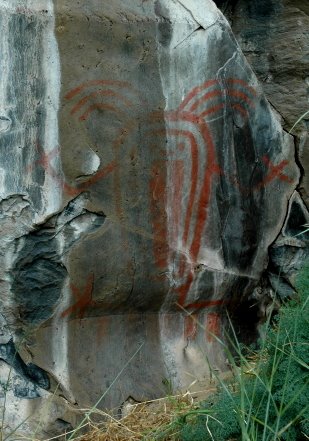
Musing about
Independence Day and how lucky Americans are to live in a free country (I mean really, we could be Hondurans or Iranians...no offense if you are) I started to wonder what Lewis and Clark did on July 4
th as they trekked through the wilderness toward the Pacific and then back again.
Google being what it is, it didn't take me long to find a copy of their journals online at a fascinating (if you're into this stuff like I am) website
(http://lewisandclarktrail.com/section1/kansascities/history2.htm) which gives you a day by day, year by year view of the journal text.
So without further ado, here's what Lewis and Clark were doing on July 4, 1804, 1805, and 1806...
July 4, 1804: By early July, the expedition had reached the
northeastern corner of the present-day state of Kansas.
Clark: "
ussered in the day by a discharge of one shot form our Bow piece, proceeded on, .Came to on the LS to refresh ourselves &
Jos Fields got bit by a snake, which was quickly
doctered with Bark by Cap Lewis . pass a creek as this Creek has no name and this day is the 4
th of July, we name this
Independance Creek . and saluted the departing day with another gun, an extra Gill of whiskey"
July 4, 1805: Portaging around the great falls of the Missouri
Lewis: "we gave the men a drink of
Sperits, it being the last of our stock, and some of them appeared a little sensible of it’s effects the fiddle was
plyed and they danced very merrily. we had a very comfortable dinner, of bacon beans, suit dumplings &
buffaloe beaf in short we had no just cause to covet the sumptuous feasts of our countrymen on this day . - one Elk and a beaver were all that was killed by the hunters today; the
buffaloe seem to have withdrawn themselves from this
neighbourhood; tho the men inform us that they are still abundant about the falls-"
July 4, 1806: On July 3, 1806, the Corps of Discovery left Travelers' Rest. Captain Lewis and nine men went to pursue a direct route to the Missouri, then explore Maria's river. Captain Clark and the rest of the party went a new route to the Jefferson River, then descended to the Three Forks and then proceeded with a detachment party to explore the Yellowstone, while Sergeant
Ordway, with nine men, descended the Missouri.
Lewis: "these
affectionate people our guides betrayed every
emmotion of unfeigned at
seperating from us."
Clark: "This day being the
decleration of
Indeendence of the United States and a Day commonly
selebrated by my country I had every disposition of
selebrate this day and therefore halted early and partook of a
Sumptious Dinner of a fat Saddle of
Vension and Mush of Cows (roots) after Dinner we proceeded on."
If you want to know more about that cool Corps of Discovery banner above, check out this website:
http://tinyurl.com/culturewatch-flag
...and on this date in other years:1776 The Continental Congress adopted the Declaration of
Independence.
1802 The U.S. Military Academy opened at West Point, N.Y.
1804 Author Nathaniel Hawthorne was born in Salem, Mass.
1826 Death claimed the second and third presidents of the United States: John Adams died at age 90 in
Braintree, Mass., while Thomas Jefferson died at 83 at Monticello, his home near
Charlottesville, Va.
1826 Songwriter Stephen Foster was born in present-day Pittsburgh.
1831 James Monroe, the fifth president of the United States, died at age 73 in New York City.
1845 American writer Henry David Thoreau began a two-year experiment in simple living at Walden Pond near Concord, Mass.
1872 Calvin Coolidge, the 30
th president of the United States, was born in Plymouth, Vt.
1939 Baseball player Lou Gehrig, afflicted with a fatal illness, bid a tearful farewell at Yankee Stadium in New York, telling fans, "Today, I consider myself the luckiest man on the face of the Earth."
1946 The Philippines became independent.
1958 Karol
Wojtyla, the future Pope John Paul II, was appointed
auxiliary bishop of Krakow, Poland, by Pope Pius XII.
1959 A 49
th star was added to the American flag to represent the new state of Alaska.
1960 The number of stars on the American flag was increased to 50 to honor the new state of Hawaii.
1966 President Lyndon B. Johnson signed the Freedom of Information Act into law.
1976 Israeli commandos raided
Entebbe airport in Uganda, rescuing almost all of the passengers and crew of an Air France jetliner seized by pro-Palestinian hijackers.
1987 Klaus Barbie, the former Gestapo chief known as the "Butcher of Lyon," was convicted by a French court of crimes against humanity and sentenced to life in prison.
2004 A 20-ton slab of granite, inscribed to honor "the enduring spirit of freedom," was laid at the World Trade Center site as the cornerstone of the Freedom Tower.
See it all at the NY Times website:
http://www.nytimes.com/learning/general/onthisday/20080704.html
 July 15, 2009 may be recorded as one of the most important days in Chinook Indian Nation history.
July 15, 2009 may be recorded as one of the most important days in Chinook Indian Nation history.























